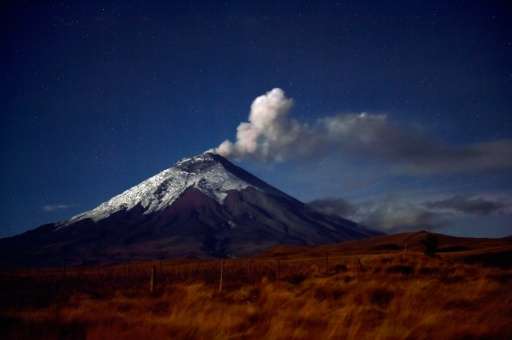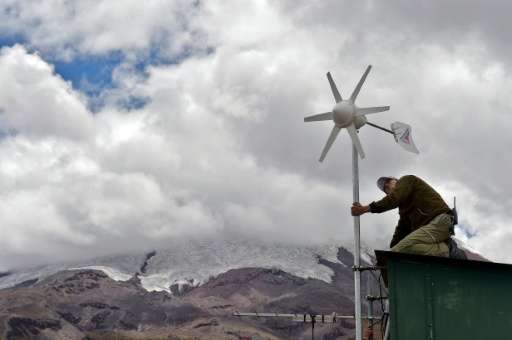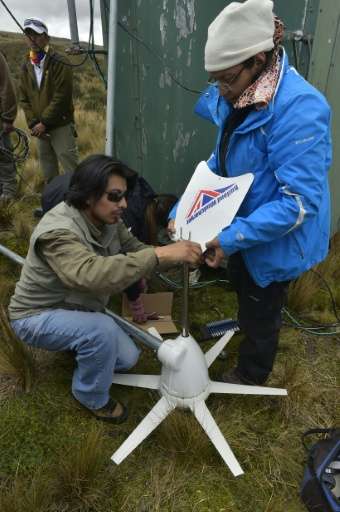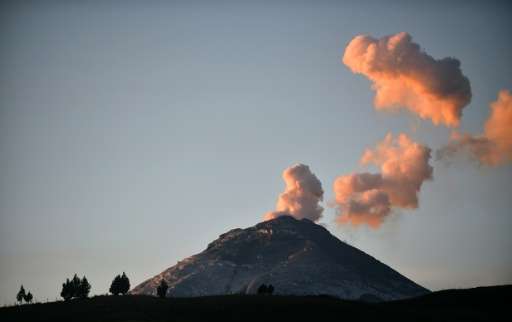Fear and beauty at foot of Ecuador's Cotopaxi volcano

Since it awoke in August from a 138-year slumber, Ecuador's Cotopaxi volcano has become one of the most-watched in the world, holding wary locals and fascinated scientists in thrall.
Cotopaxi, whose snowy peak rises majestically from the patchwork quilt of central Ecuador's high plains, rumbled to life on August 14, belching a column of ash in its first major eruption since 1877.
President Rafael Correa declared a state of emergency as authorities warned the volcano was one of the most dangerous on Earth because of its big snow cap and the relatively large population nearby.
So far, the fiery explosion of lava and cataclysmic snow-melt the government feared have not materialized.
But scientists are keeping a wary eye on Cotopaxi.
A team from Ecuador's Geophysics Institute recently climbed to the last shelter before the crater and installed wind-powered generators to keep their monitoring equipment running in case it gets covered by volcanic ash.
"This is the most monitored volcano in South America. We can't rule out any scenario," said the institute's director, Mario Ruiz.
Touring the ruddy terrain around the volcano's base, where herds of wild horses run amid the meadows and lakes, Ruiz pointed out the deep grooves carved by the 1877 eruption.
"In the 10 kilometers (six miles) immediately surrounding Cotopaxi there's almost no one and nothing," Ruiz told AFP.
"But there's a possibility the volcano could generate pyroclastic flows—a mix of gas, ashes and rock fragments—that could melt the glacier and form rivers of mud and debris, or lahars, which could affect the surrounding population for dozens of kilometers."

A powerful eruption is unlikely, he said.
But if it happened, it would have a devastating impact on an area that is home to 325,000 people, an oil pipeline and a key agriculture industry and sits just 45 kilometers south of the capital Quito.
'Marvelous' but scary
During the August eruption, authorities evacuated hundreds of people and closed tens of thousands of hectares (acres) of the national park that surrounds the 5,897-meter (19,347-foot) volcano.
President Correa also decreed a controversial "prior censorship" measure that barred the media from releasing any unauthorized information on the volcano.
Residents who live near the volcano have grown used to living in a state of "yellow alert," the second scale on Ecuador's four-level warning system. They go about their days as Cotopaxi spits large volumes of ash and gas into the sky.
"I live with the joy of having this marvelous volcano nearby, but with the fear that it could turn destructive," said Roberto Veloz, who lives in the small town of El Pedregal, 10 kilometers from the volcano.
The three states considered to be at risk—Cotopaxi, Napo and Pichincha—periodically organize eruption drills. But they have not released estimates of the economic impact an eruption would have.

'Reducing uncertainty'
Visitors to the Geophysics Institute's headquarters in Quito are greeted by a map of mainland Ecuador's 84 volcanos, color-coded as dormant, potentially active, active or erupting.
A monitoring room receives real-time data from 60 stations installed around Cotopaxi, which is analyzed 24 hours a day by a team of 80 experts.
"Volcanic processes develop underground. We can't measure them directly," said Ruiz as he watched a panel of six large screens with data from instruments like infrared cameras and level gauges.

"We measure the number and the intensity of seismic events, the deformation or leak of gases... and try to establish a scenario of how it could evolve," he said.
Ruiz, a 30-year veteran of the Institute, said there was little time for a breather even though Cotopaxi's risk level was recently downgraded from moderate to low.
"We've entered into the stage of uncertainty. Our work now is to reinforce what we know with more data to reduce that uncertainty," he said.
© 2015 AFP

















